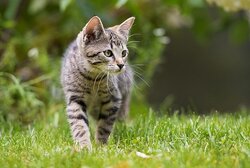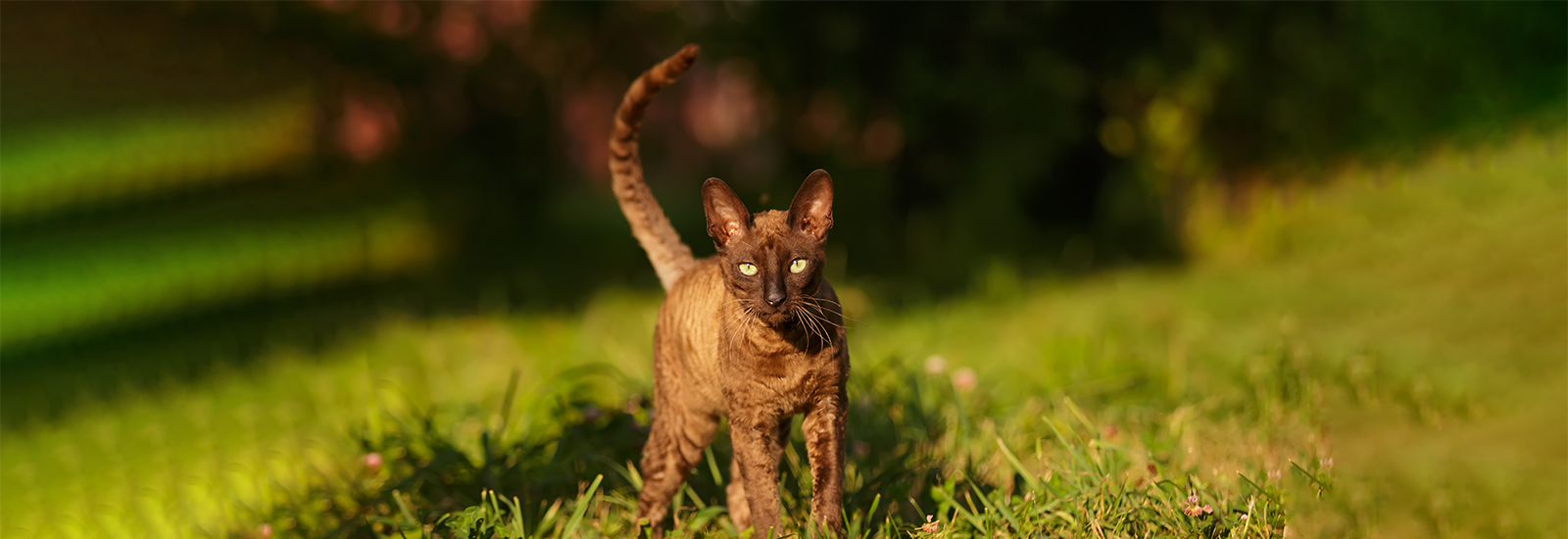Cornish Rex
Thanks to a whim of nature and some dedicated breeders, we have the Cornish Rex. This curly-haired cat evolved from a domestic shorthair. Just like the domestic shorthair, the Cornish Rex is inquisitive, playful and energetic.
Profile of the Cornish Rex
- Size small
- Weight female: approx. 2.5 kg, male: approx. 3.5 kg
- Origin England
- Build slim, strong
- Length of fur short, curly
- Colour of fur all colours
- Grooming easy
- Behaviour high-spirited, affectionate
- Character inquisitive, not prone to stress
Appearance and character of the Cornish Rex
Cats with wavy or curly coats are always a major attraction at cat shows. This also applies to the Cornish Rex, which is one of the best-known examples of this type of cat. Its distinctive coat immediately catches everyone’s eye. However, this is not the outer fur, but the undercoat. This is short, dense and rather fluffy. According to the breed standard, the fur should lie close on the body and be wavy, especially on the back and sides. The colour and pattern of the coat is not important. It can have one, two or three colours and can also be tabby or spotted. There is just as much variety as with our domestic shorthairs. These do, however, tend to be somewhat larger and not as slender as the graceful Cornish Rex. Their bodies are of medium length, elegant, and muscular despite their dainty appearance. The legs are quite long, and the ears and eyes are large, although the tail is remarkably thin. There are no specific requirements regarding the colour of the eyes, but it should be as clear and pure as possible.
The Cornish Rex is a playful and high-spirited breed of cat, but it can also be gentle and affectionate. This can, however, change quickly, which is not unusual for cats. Cornish Rex cats do not mind strangers and tend to be friendly towards them. However, they only become real sweethearts when they are with their favourite humans. They simply adore the close contact with them and when someone has settled down on the sofa, they will not wait long before they join them. Similarly, these curious cats are quickly on the scene when something interesting happens in their home. They are not particularly shy or prone to stress, and are highly adaptable. They are less talkative than, for example, an Oriental Shorthair, but will make themselves heard in their soft little voices when they have something to say.
Keeping and caring for a Cornish Rex cat
Having a Cornish Rex as a pet is normally not at all problematic. They are not especially demanding, nor do they have problems when things get a little louder in a family with children. The only important thing is that they have a safe place where they can retreat to if they are feeling scared or apprehensive. A tall cat tree is ideal for this purpose and can also serve as a viewing platform, as a place to take a nap, or for chasing games. The Cornish Rex, will of course need another cat for this type of activity. Although they love to have a companion, they can also thrive as a single cat provided they are given enough attention and are not regularly left alone for extended periods. They love having plenty of different cat toys and other items to help them pass the time.
It is important to remember that the Cornish Rex only has a thin coat. It should therefore not be left to bask in the sun on the balcony for hours on end, because it could get a sunburn. In the winter months, on the other hand, it will need to keep warm. The room temperature should not be too low, and cuddly caves, cosy cat beds and snug blankets will be much appreciated. It is not advisable to let them outside, especially in the colder months, because their thin fur is sensitive to moisture and only provides minimal protection against the cold.
The Cornish Rex is very easy to care for. It neither loses a lot of hair nor does it need to be constantly combed. All you need to do is run a soft brush over its coat every now and then.
Nutrition
Whether it’s a kitten, an adult cat or a senior – the food for a Cornish Rex cat should always be of high quality and tailored to its age. Cats are carnivores by nature, so cat food should always contain a high proportion of meaty ingredients. Sugar, flavour enhancers and artificial colourings and preservatives do not belong in the food.
animonda has the ideal food for every stage of your cat’s life. You can choose between kitten, adult and senior cat food. The products are specially formulated to meet the specific nutritional requirements of the different life stages of cats. This provides the best foundation for your pet to enjoy a long and healthy life.
Health of the Cornish Rex
The ancestors of the Cornish Rex are normal domestic shorthairs, which generally tend to be very healthy. It is however also the case that many Rex cats only have a very limited gene pool. The less fresh blood is introduced into a breeding programme, the greater the risk of immune disease or a reduced life expectancy. For example, gum and root infections occasionally occur.
The rate of hair growth of the Cornish Rex must also be viewed critically. If this is in accordance with the breed standard, then it is not a problem. A dense, tight coat and curly or curved whiskers are specified. The breeding is, however, relevant from an animal welfare point of view if the cat has bald patches or even missing whiskers. Animal welfare legislation requires that no suffering, harm or disorders be caused or tolerated. Most countries do not have a ban on breeding the Cornish Rex, however restrictions will sometimes apply in individual cases, particularly as regards certain Cornish Rex variants.
History and breeding
Naturally occurring mutations are a regular occurrence in the animal kingdom. These can, for example, have an effect on the colour of the fur or, in the case of Rex cats, on the fur texture. This is what happened in the early 1950s in Cornwall, when a male cat with curly hair was found in a litter of normal farmyard kittens. It wasn’t just its owners who were delighted with this special cat named “Kallibunker”, but also the geneticist AC Jude, who had heard about the incident. He advised them to mate Kallibunker with his mother as soon as he reached sexual maturity. This proved to be a success and three kittens were born, two of which really did have wavy hair. This was proof that the mutation could be inherited. And so, with Kallibunker as the original forefather, the pure breeding of the Cornish Rex started.
When another curly-haired male was born nearby several years later, the owners got in contact with each other, because they were both interested in being able to add fresh blood in order to continue breeding in an optimum way. One of Kallibunker's daughters was paired with “Kirlee”. However, to everyone's surprise, only straight-haired kittens were born. The two genetic defects were obviously different and therefore incompatible. It is due to this fact that breeding of the Devon Rex began with Kirlee. In both cases, normal domestic shorthairs were also used, until the number of purebred cats kept increasing. In 1968, the European governing body, FIFe, finally officially recognised the Cornish Rex. A year earlier, the breed had already achieved recognition by the Cat Fanciers’ Association in the USA.
You may also like this

Feeding kittens - nutrition tips
What small kittens need for healthy development

Good cat food
How to recognize good cat food for your darling

A kitten is moving in
Tips for collection, initial equipment and settling in

Getting your cat used to being outdoors
How to get your cat used to going outside

